Effect of Wind-Wave-Current Interaction on Oil Spill in the Yangtze River Estuary
Abstract
1. Introduction
2. Materials and Methods
2.1. Hydrodynamic Model
2.1.1. Hydrodynamic Simulation
2.1.2. Study Area and Parameters Setup
2.1.3. Model Verification
2.2. Oil Spill Model
2.2.1. Physical Transport
2.2.2. Weathering of Spilled Oil
2.2.3. Beaching and Shore Lock-Reflection
2.2.4. Oil Spill Simulation in the YRE
3. Results
3.1. Oil Spill Trace before, during, and after Typhoon
3.1.1. Before Typhoon Landed
3.1.2. During Typhoon
3.1.3. After Typhoon Passage
3.2. Oil Spill Spread and Slick Thickness
4. Discussion
4.1. Influence of Wind Direction
4.2. Effects of Different Wind Speeds
4.3. Effects of Current Speeds
5. Conclusions
- (1)
- In case the oil spill occurs when the typhoon lands. Due to the high waves and strong winds, the oil film dives faster under the action of wave breaking and entrainment, so that the oil spill at the water surface is only about 20% of the total. Most oil particles sink into the water columns towards the sea bed, it is therefore important to pay more attention to the cleaning of the seabed in a timely manner. If the mean wave direction is not against the current, the swept area is larger. In the case of small wind speeds, the influence of wave is slight. Even during the typhoon, wave directions affect not so large. For the oil spill that occurs after the typhoon, the current speed is large and can move the oil farther, which has a greater impact on the vulnerable area of the YRE. More timely and efficient measures should be taken to control the oil pollution.
- (2)
- Influence of wind direction: when only the summer wind is present only, the oil spill is relatively concentrated, and the affected area is limited because of the opposite current and wind direction. When the winter wind is present, which coincides with the current direction, the coupled action of wind and current can drive the oil farther, resulting in the swept area about seven times that during the summer.
- (3)
- The influence of wind speed: a stronger wind speed affects the movement of the oil film following the wind direction, instead of following the current to the deep trough. The oil film reaches the shallow water area and dive quickly, resulting in the separation and fragmentation of the oil film and increasing the uncertainty of the swept area prediction. Meanwhile, the wind will also make the oil film move closer to the shoreline, causing pollution in the coastal natural reserve and affecting water intake.
- (4)
- The influence of current speed: the impact area will be larger due to the superposition of runoff and tidal current.
Author Contributions
Funding
Institutional Review Board Statement
Informed Consent Statement
Data Availability Statement
Acknowledgments
Conflicts of Interest
References
- Pan, L.Z.; Lin, X.B.; Chang, J.F.; Zheng, X.Q.; Lv, X.; Wang, X.X.; Li, Y.S. Characteristics and Implications of Ship Oil-Spill Accidents in Changjiang Estuary and Coastal Areas of Shanghai Port. Trans. Oceanol. Limnol. 2016, 5, 37–43. [Google Scholar] [CrossRef]
- Li, Y.; Yang, Y.Q.; Pan, Q.Q. Review on the oil spill numerical forecasting technology. Mar. Forecast. 2017, 34, 89–98. [Google Scholar]
- Jin, G. Numerical Simulation of Oil Spill Based on Three-dimensional Tidal Flow Field; Dalian Maritime University: Dalian, China, 2019. [Google Scholar]
- Yang, H. The Study of Ecological Risk Zoning and Emergency Countermeasures of Oil Spills on Shanghai Ocean Area; Shanghai Ocean University: Shanghai, China, 2014. [Google Scholar]
- Alea, C.; Ruiz, C.I.; Yap, J.B.; Molina, E.F.; Saballa, A.J.; Ñuneza, J.S.; Bacharo, K.B.B. An Investigation of Aquatic Oil Spills in the Philippines from 2000 to 2021. Mar. Pollut. Bull. 2022, 185, 114241. [Google Scholar] [CrossRef] [PubMed]
- Malcolm, L. Spaulding State of the Art Review and Future Directions in Oil Spill Modeling. Mar. Pollut. Bull. 2017, 115, 7–19. [Google Scholar] [CrossRef]
- Fu, H.R. Study on the Submerging Mechanism of Floating Oil under Wave Action and Dispersant Treatment Technology; Dalian Maritime University: Dalian, China, 2020. [Google Scholar]
- Jiang, W.X. Study on the Simulation of Accidental Oil Spill in the Huangpu River; Tongji University: Shanghai, China, 2007. [Google Scholar]
- Lou, S.; Liu, S.G. Review in Theory and Study of Oil Spill Models. Environ. Sci. Manag. 2008, 10, 33–37+61. [Google Scholar]
- Liu, Z.K.; Chen, Q.; Zheng, C.; Han, Z.H.; Cai, B.P.; Liu, Y.H. Oil Spill Modeling of Chengdao Oilfield in the Chinese Bohai Sea. Ocean Eng. 2022, 255, 111422. [Google Scholar] [CrossRef]
- Liu, Z.K.; Chen, Q.; Zhang, Y.W.; Zheng, C.; Cai, B.P.; Liu, Y.H. Research on Transport and Weathering of Oil Spills in Jiaozhou Bight, China. Reg. Stud. Mar. Sci. 2022, 51, 102197. [Google Scholar] [CrossRef]
- Gu, J.H.; Zhu, J.R.; Jin, Z. Numerical simulation of oil film drift and diffusion after oil spill accident at the Baosteel wharf in the Changjiang Estuary. J. Trop. Oceanogr. 2022, 41, 159–170. [Google Scholar]
- Gui, Q.; Shi, Y.P.; Chen, J.H. Risk analysis of oil spills in Yangtze River Estuary on water intake of Dongfengxisha Reservoir. Yangtze River 2012, 43, 78–81. [Google Scholar] [CrossRef]
- Chen, H.; Lu, S.Q.; Shao, Y.P.; Wang, B.; Liu, Y. Study on oil spill risk zoning in the Yangtze River Estuary based on the visited probability method of sensitive targets. J. Environ. Eng. Technol. 2023, 13, 47–53. [Google Scholar] [CrossRef]
- Chen, Y.Z. Development and application of water pollution emergency response system in Yangtze River Estuary. Yangtze River 2013, 44, 5–9. [Google Scholar] [CrossRef]
- Huang, S.F. Study on Ecological Environmental Impact Assessment and Remediation Technical Scheme of Oil Spill Accident in Changjiang Estuary; Shanghai Academy of Environmental Sciences: Shanghai, China, 2015. [Google Scholar]
- Chen, S.Q. Three-Dimensional Numerical Simulation of the Influence of Accident-Induced Oil Film on the Water Source in Huangpu River and Changjiang Estuary; East China Normal University: Shanghai, China, 2012. [Google Scholar]
- Li, S.S.; Li, R.J.; Feng, Q.; Xiao, Q.L. Numerical simulation of oil spill risk in sea area near Gouqi Island in Yangtze River estuary. Yangtze River 2014, 45, 65–69. [Google Scholar] [CrossRef]
- Li, Y.S.; Pan, L.Z. Numerical simulation of oil spill trajectory in Yangtze River estuary. J. Shanghai Ocean Univ. 2014, 23, 238–244. [Google Scholar]
- Yin, J.; Chen, Z.Z.; Liang, S.S. Numerical Simulation of Oil Spill Accident Influence on Drinking Water Source of Qingcaosha Reservoir in Yangtze Estuary Region. Water Purif. Technol. 2014, 33, 41–48+77. [Google Scholar] [CrossRef]
- Yang, H.; Liu, C.X.; Li, Y.S.; Ding, L.L. Numerical simulation of oil-spill in the south channel of the stuary Yangtze River estuary. Mar. Sci. Bull. 2013, 32, 345–351. [Google Scholar]
- Yang, H.; Liu, C.X.; Li, Y.S.; Pan, L.Z.; Ding, L.L. Simulation of oil spill in anchorage out of Yangtze River Estuary based on GNOME. J. Shanghai Ocean Univ. 2013, 22, 384–390. [Google Scholar]
- Niu, Q.; Xia, M. The Role of Wave-Current Interaction in Lake Erie’s Seasonal and Episodic Dynamics. J. Geophys. Res. Ocean. 2017, 122, 7291–7311. [Google Scholar] [CrossRef]
- Wang, J.; Kuang, C.P.; Chen, K.; Fan, D.D.; Qin, R.F.; Han, X.J. Wave–Current Interaction by Typhoon Fongwong on Saline Water Intrusion and Vertical Stratification in the Yangtze River Estuary. Estuar. Coast. Shelf Sci. 2022, 279, 108138. [Google Scholar] [CrossRef]
- Zou, Q.; Chen, H. Wind and Current Effects on Extreme Wave Formation and Breaking. J. Phys. Oceanogr. 2017, 47, 1817–1841. [Google Scholar] [CrossRef]
- Chen, H.; Zou, Q. Geometry of Deep and Intermediate Water Breaking Waves Influenced by Wind Speed and Direction. Phys. Fluids 2022, 34, 087126. [Google Scholar] [CrossRef]
- Olabarrieta, M.; Warner, J.C.; Kumar, N. Wave-Current Interaction in Willapa Bay. J. Geophys. Res. Ocean. 2011, 116, C12014. [Google Scholar] [CrossRef]
- Chen, H.; Zou, Q. Characteristics of Wave Breaking and Blocking by Spatially Varying Opposing Currents. J. Geophys. Res. Oceans 2018, 123, 3761–3785. [Google Scholar] [CrossRef]
- Chen, H.; Zou, Q. Effects of Following and Opposing Vertical Current Shear on Nonlinear Wave Interactions. Appl. Ocean Res. 2019, 89, 23–35. [Google Scholar] [CrossRef]
- Xie, D.; Zou, Q.; Cannon, J.W. Application of SWAN+ADCIRC to Tide-Surge and Wave Simulation in Gulf of Maine during Patriot’s Day Storm. Water Sci. Eng. 2016, 9, 33–41. [Google Scholar] [CrossRef]
- Zou, Q.; Xie, D. Tide-Surge and Wave Interaction in the Gulf of Maine during an Extratropical Storm. Ocean Dyn. 2016, 66, 1715–1732. [Google Scholar] [CrossRef]
- Gong, W.; Chen, Y.; Zhang, H.; Chen, Z. Effects of Wave–Current Interaction on Salt Intrusion During a Typhoon Event in a Highly Stratified Estuary. Estuaries Coasts 2018, 41, 1904–1923. [Google Scholar] [CrossRef]
- Wu, L.; Wang, B.; Geng, S. Growing Typhoon Influence on East Asia. Geophys. Res. Lett. 2005, 32, L18703. [Google Scholar] [CrossRef]
- Xia, M.Y.; Xu, F.M.; Wen, Y.C. Study of storm surge distribution along the Yangtze River and Estuary under different typhoon tracks. Ocean Eng. 2022, 40, 115–122. [Google Scholar] [CrossRef]
- Xu, M.; Chang, C.P.; Fu, C.; Qi, Y.; Robock, A.; Robinson, D.; Zhang, H. Steady Decline of East Asian Monsoon Winds, 1969–2000: Evidence from Direct Ground Measurements of Wind Speed. J. Geophys. Res. Atmos. 2006, 111, D24111. [Google Scholar] [CrossRef]
- Yihui, D. Monsoons over China; Springer: Dordrecht, The Netherlands, 1994; ISBN 978-90-481-4161-6. [Google Scholar]
- Hydrodynamic and Transport Module Scientific Documentation, MIKE 21 FLOW MODEL FM; MIKE by DHI: Copenhagen, Denmark, 2014.
- Kuang, C.P.; Chen, K.; Wang, J.; Wu, Y.L.; Liu, X.; Xia, Z.L. Responses of Hydrodynamics and Saline Water Intrusion to Typhoon Fongwong in the North Branch of the Yangtze River Estuary. Appl. Sci. 2021, 11, 8986. [Google Scholar] [CrossRef]
- Sleigh, P.A.; Gaskell, P.H.; Berzins, M.; Wright, N.G. An unstructured finite-volume algorithm for predicting flow in rivers and estuaries. Comput. Fluids 1998, 27, 479–508. [Google Scholar] [CrossRef]
- Hersbach, H.; Bell, B.; Berrisford, P.; Hirahara, S.; Horányi, A.; Muñoz-Sabater, J.; Nicolas, J.; Peubey, C.; Radu, R.; Schepers, D.; et al. The ERA5 Global Reanalysis. Q. J. R. Meteorol. Soc. 2020, 146, 1999–2049. [Google Scholar] [CrossRef]
- Oil Spill Model User Guide, MIKE-21/3 Oil Spill; MIKE by DHI: Copenhagen, Denmark, 2014.
- Particle Tracking Module Scientific Documentation, MIKE 21 & MIKE 3 FLOW MODEL FM; MIKE by DHI: Copenhagen, Denmark, 2014.
- Al-Rabeh, A.H. Estimating Surface Oil Spill Transport Due to Wind in the Arabian Gulf. Ocean Eng. 1994, 21, 461–465. [Google Scholar] [CrossRef]
- Mackay, D.; Paterson, S.; Trudel, K.; Reed, M.; Johansen, Ø.; Brandvik, P.; Daling, P.; Lewis, A.; Fiocco, R.; Prentki, R. A Mathematical Model of Oil Spill Behaviour. Environment Canada Report EE7; Environmental Protection Service: Ottawa, ON, Canada, 1980. [Google Scholar]
- Fingas, M. The Evaporation of Oil Spills: Prediction of Equations Using Distillation Data. Spill Sci. Technol. Bull. 1996, 3, 191–192. [Google Scholar] [CrossRef]
- Fingas, M.F. Studies on the Evaporation of Crude Oil and Petroleum Products: I. the Relationship between Evaporation Rate and Time. J. Hazard. Mater. 1997, 56, 227–236. [Google Scholar] [CrossRef]
- Fingas, M.F. Modeling Evaporation Using Models That Are Not Boundary-Layer Regulated. J. Hazard. Mater. 2004, 107, 27–36. [Google Scholar] [CrossRef] [PubMed]
- Xie, H.; Yapa, P.D.; Nakata, K. Modeling Emulsification after an Oil Spill in the Sea. J. Mar. Syst. 2007, 68, 489–506. [Google Scholar] [CrossRef]
- Sebastião, P.; Guedes Soares, C. Modeling the Fate of Oil Spills at Sea. Spill Sci. Technol. Bull. 1995, 2, 121–131. [Google Scholar] [CrossRef]
- Delvigne, G.A.L.; Sweeney, C.E. Natural Dispersion of Oil. Oil Chem. Pollut. 1988, 4, 281–310. [Google Scholar] [CrossRef]
- Shen, H.T.; Yapa, P.D.; Wang, D.S.; Yang, X.Q. A Mathematical Model for Oil Slick Transport and Mixing in Rivers; Cold Regions Research and Engineering Lab.: Hanover, NH, USA, 1993. [Google Scholar]
- Xie, F.; Yan, H.Y.; Wang, X.H. Numerical Simulation Research and Application of Oil Spill Accident in Taicang Section of the South Branch of the Yangtze River Estuary. China Resour. Compr. Util. 2021, 39, 65–69. [Google Scholar]
- Huang, R.; Han, L.X.; Zhang, F.X. Numerical Modelling of Oil Spill Accidents in the Yangtze River. J. Yangtze River Sci. Res. Inst. 2019, 36, 9–13. [Google Scholar] [CrossRef]
- Wu, J. Study on Pollution Stress and Ecological Damage Assessment of Oil Spill in Estuarine Tidal Flat Ecosystem; East China Normal University: Shanghai, China, 2017. [Google Scholar]
- Zhao, C. Accident Investigation about Self Sink of MV “Shanhong 12” on 30th December in Jiangsu. China Marit. Safety 2015, 2, 43. [Google Scholar]
- Du, N.; Zhang, R.B.; Wei, F.S. Thoughts on Repairing Baimaosha Water Area after Oil Spill Accident. China Water Resour. 2015, 4, 45–46. [Google Scholar]
- Zhang, X.; Li, D.Y. Research on density correction method of ship fuel. Ship Sci. Technol. 2021, 43, 126–128. [Google Scholar]
- Dai, R.; Zhu, J.R. Statistical analysis of the wind at the Chongming eastern beach. J. East China Norm. Univ. (Nat. Sci.) 2015, 4, 17–25. [Google Scholar] [CrossRef]
- Wu, Q.Y. Characteristics and Variation Trend of Wind and Waves in the Yangtze Estuary and Adjacent Seas over the Past 40 Years; East China Normal University: Shanghai, China, 2020. [Google Scholar]
- Fan, M.Y.; Li, J.H.; Wan, Y.Y.; Guo, H. Effect of runoff change on hydrodynamic characteristics of the Yangtze River estuary. Ocean Eng. 2020, 38, 81–90. [Google Scholar] [CrossRef]
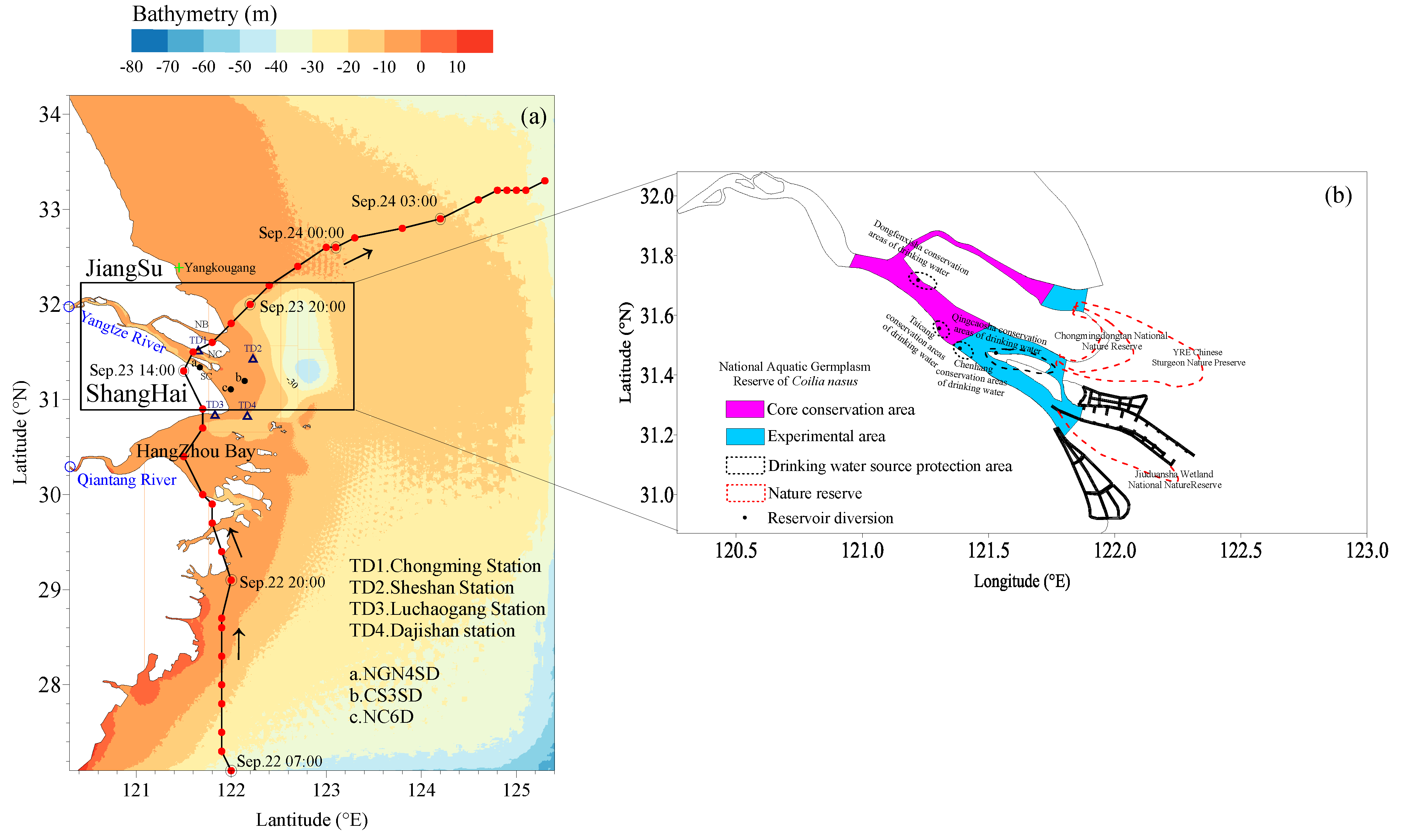



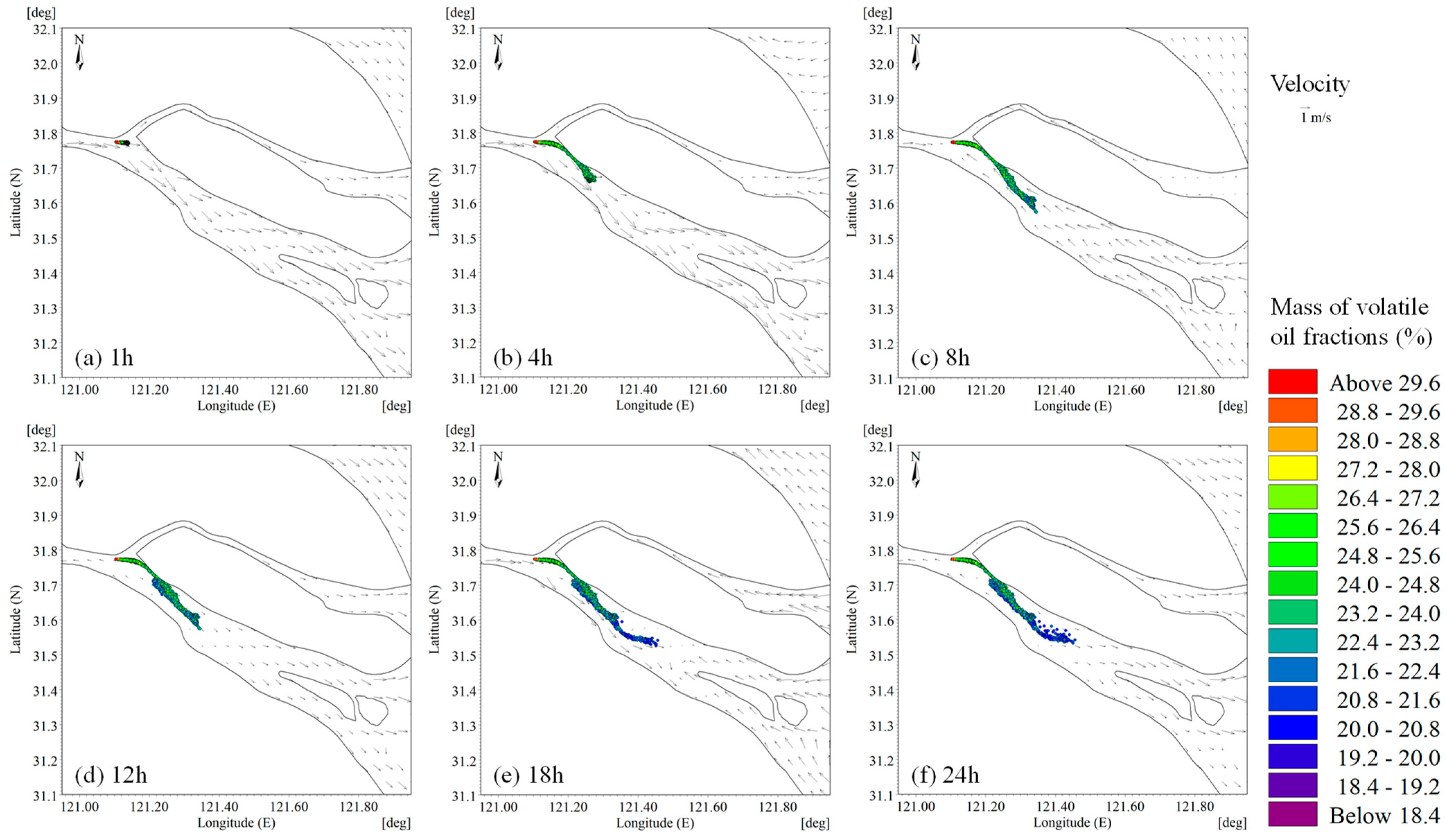

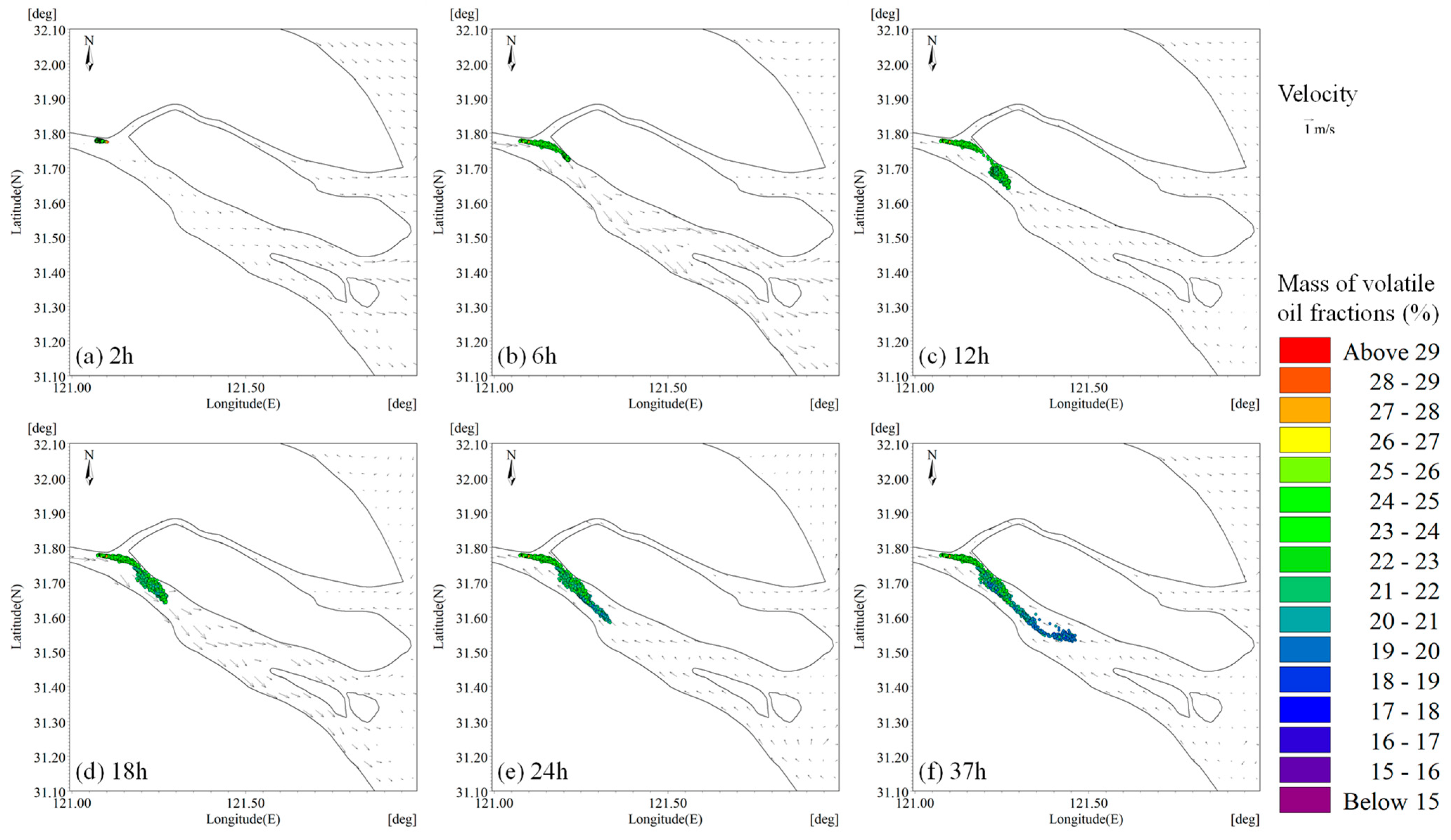
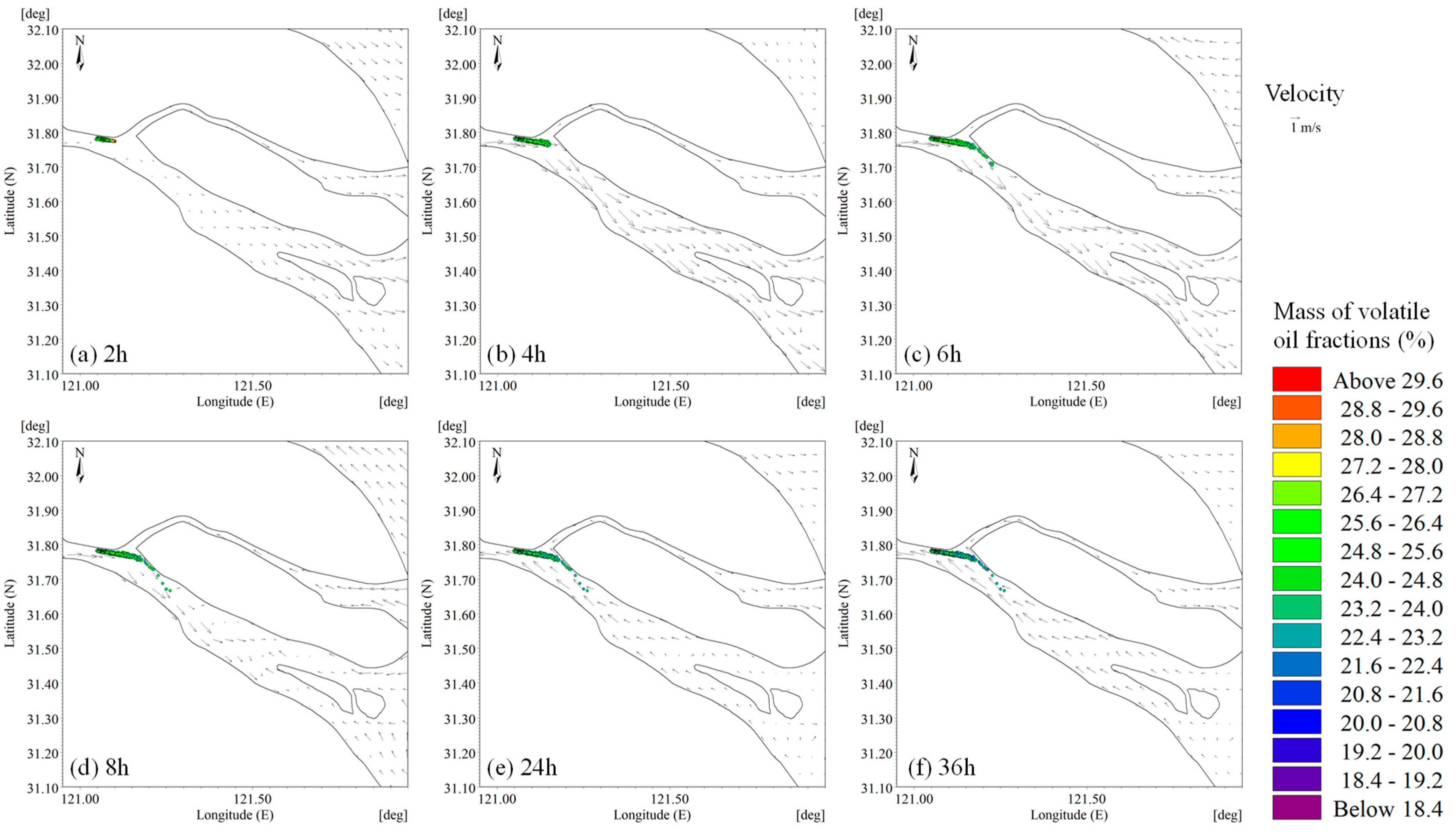
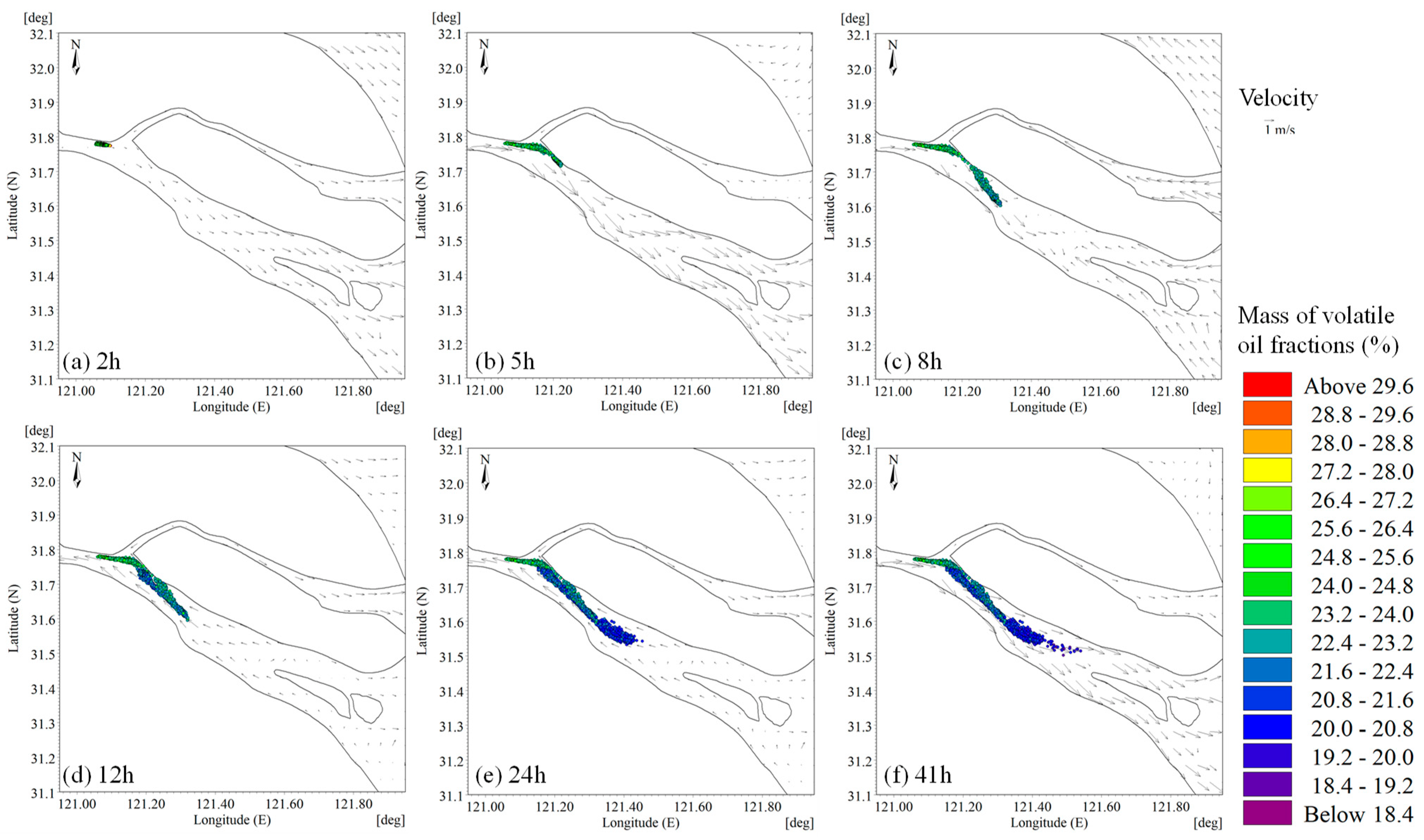






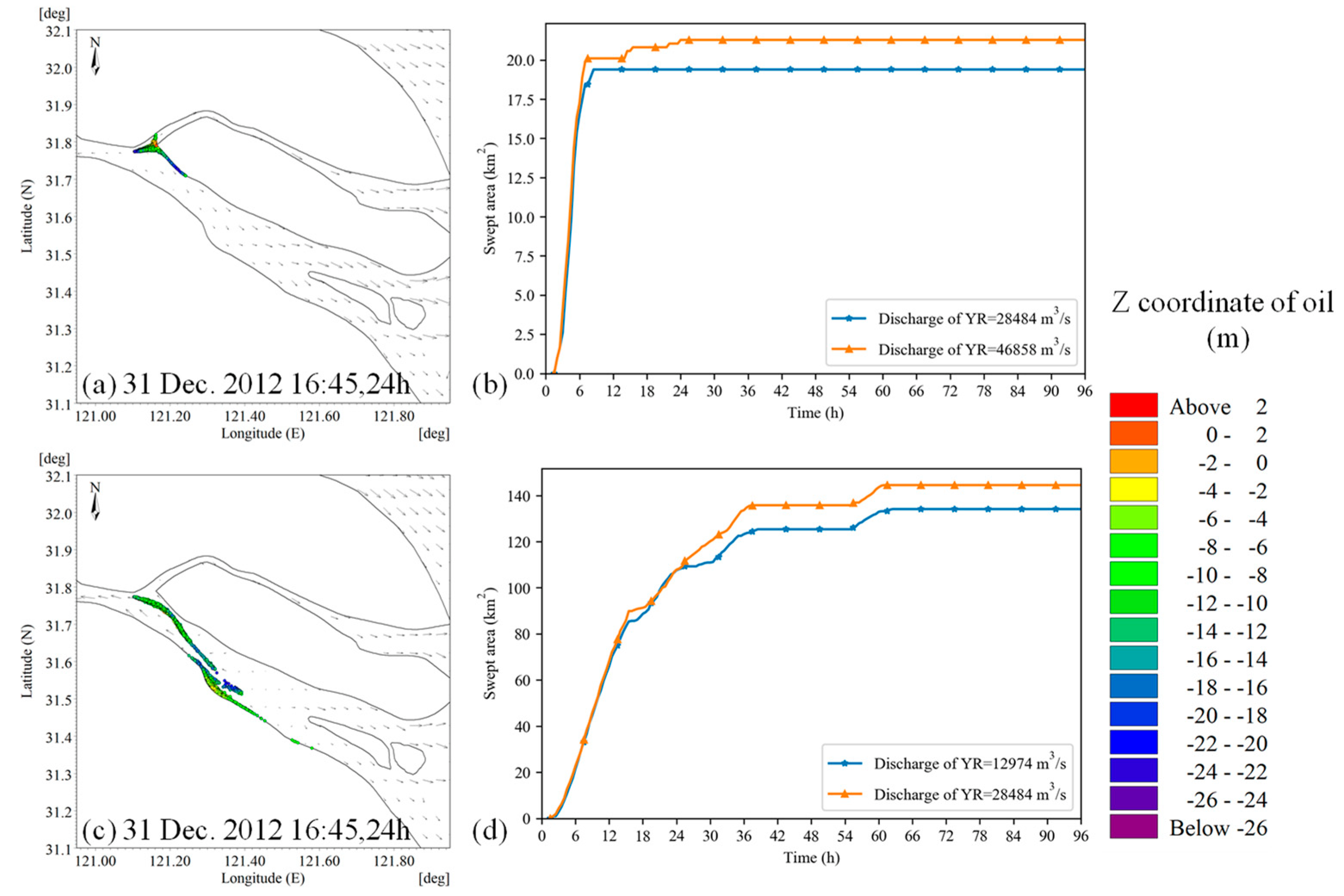
| Name | Value |
|---|---|
| Ship name | Shanhong 12 |
| Port of registry | Bengbu, Anhui Province, China |
| Type | Oil tanker |
| Tonnage | 336 tons for gross tonnage and 188 tons for net tonnage |
| Main engines | One for 200 kW |
| Operating Parameters | Specific Descriptions |
|---|---|
| Simulation time | 30 December 2012–2 January 2013 |
| Environment condition | Historical wind, current, and wind-driven wave fields data |
| Scene setting | Spill site (121.11° E, 31.77° N); continuous oil spill; 4000 oil particles; spill volume of 400 tons; horizontal dispersion coefficient of 1 m2/s; vertical dispersion coefficient of 0.15 m2/s |
| Simulation Start Time | Period |
|---|---|
| 19 September 2014 23:00 | Before typhoon |
| 23 September 2014 01:00 | During typhoon |
| 25 September 2014 02:00 | After typhoon |
Disclaimer/Publisher’s Note: The statements, opinions and data contained in all publications are solely those of the individual author(s) and contributor(s) and not of MDPI and/or the editor(s). MDPI and/or the editor(s) disclaim responsibility for any injury to people or property resulting from any ideas, methods, instructions or products referred to in the content. |
© 2023 by the authors. Licensee MDPI, Basel, Switzerland. This article is an open access article distributed under the terms and conditions of the Creative Commons Attribution (CC BY) license (https://creativecommons.org/licenses/by/4.0/).
Share and Cite
Kuang, C.; Chen, J.; Wang, J.; Qin, R.; Fan, J.; Zou, Q. Effect of Wind-Wave-Current Interaction on Oil Spill in the Yangtze River Estuary. J. Mar. Sci. Eng. 2023, 11, 494. https://doi.org/10.3390/jmse11030494
Kuang C, Chen J, Wang J, Qin R, Fan J, Zou Q. Effect of Wind-Wave-Current Interaction on Oil Spill in the Yangtze River Estuary. Journal of Marine Science and Engineering. 2023; 11(3):494. https://doi.org/10.3390/jmse11030494
Chicago/Turabian StyleKuang, Cuiping, Jilong Chen, Jie Wang, Rufu Qin, Jiadong Fan, and Qingping Zou. 2023. "Effect of Wind-Wave-Current Interaction on Oil Spill in the Yangtze River Estuary" Journal of Marine Science and Engineering 11, no. 3: 494. https://doi.org/10.3390/jmse11030494
APA StyleKuang, C., Chen, J., Wang, J., Qin, R., Fan, J., & Zou, Q. (2023). Effect of Wind-Wave-Current Interaction on Oil Spill in the Yangtze River Estuary. Journal of Marine Science and Engineering, 11(3), 494. https://doi.org/10.3390/jmse11030494








